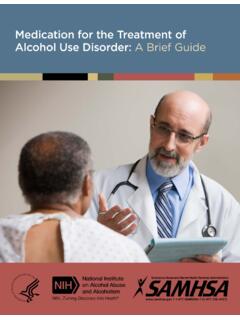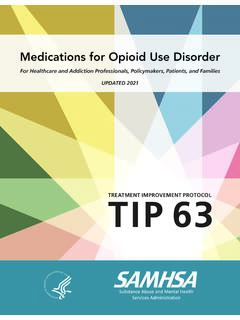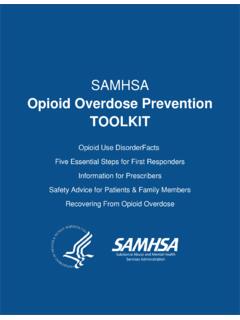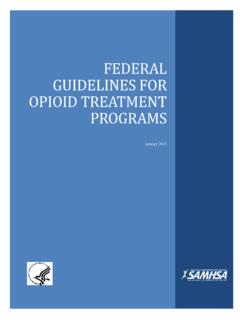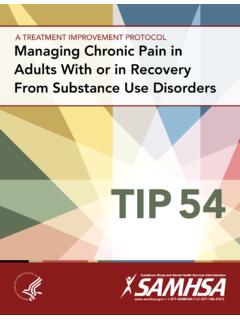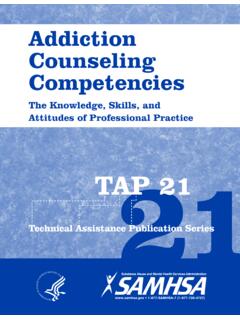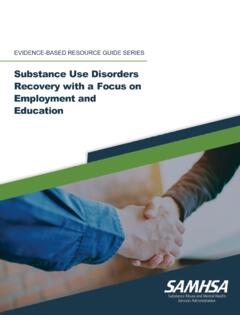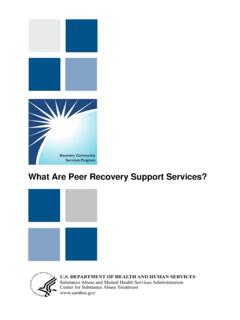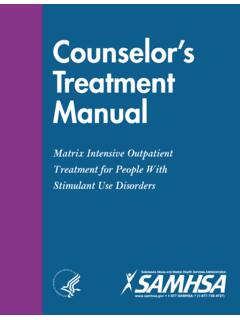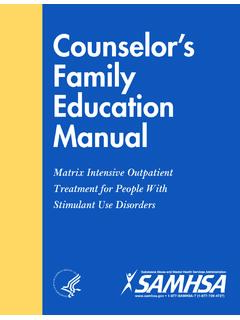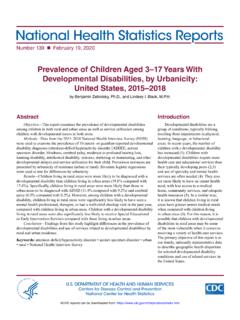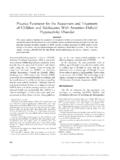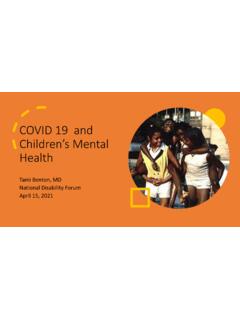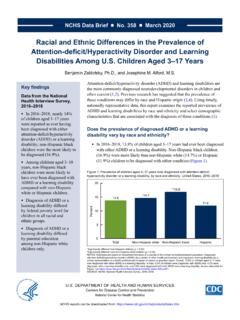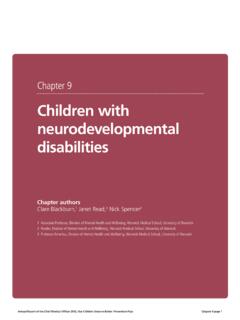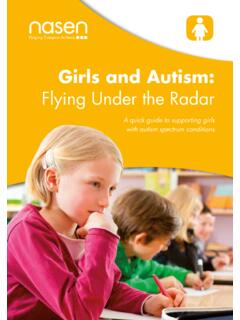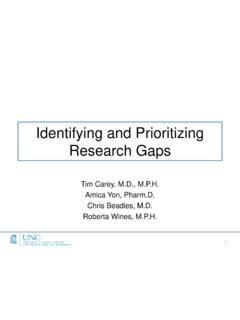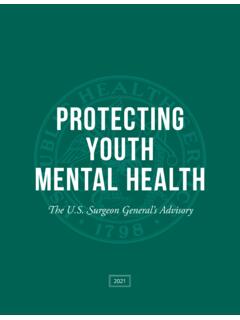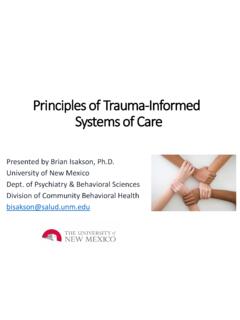Transcription of Prescription Stimulant Misuse and Prevention Among Youth ...
1 ADVISORYS ubstance Abuse and Mental HealthServices Administration1 Prescription Stimulant Misuse AND Prevention Among Youth AND YOUNG ADULTSThe Misuse of Prescription pain relievers, tranquilizers, sedatives, and stimulants Among Youth and young adults aged 12 to 25 is a major public health issue in the United States. The prevalence of Prescription drug Misuse is highest Among young adults between the ages of 18 and 25; over 11 percent report the Misuse of Prescription drugs in the past Similarly, over 4 percent of Youth between the ages of 12 and 17 report Prescription drug Misuse in the past Although the overall prevalence of Prescription drug Misuse Among Youth and young adults has declined in recent years,1 its relatively high rate Among young adults, in particular, is concerning. In this age category, the rates of Prescription Stimulant Misuse are higher than the rates of Misuse for other categories of Prescription In this advisory, Prescription Stimulant Misuse includes: Using medication without a Prescription of one s own, even if with therapeutic intent; Using medication in greater amounts, more often, or longer than prescribed; Using medication in any way other than directed by a prescriber ( , non-medical use); or Using medication for recreational purposes or without therapeutic advisory occasionally uses the phrase non-medical use of Prescription stimulants when citing studies that use this of ContentsAbout Stimulants.
2 2 Types of Stimulants ..3 Prescription Stimulants ..4 Prevalence of Prescription Stimulant Use/ Misuse .. 5 Health Effects of Prescription Stimulant Misuse Among Youth and Young Adults ..5 Risk Factors for Prescription Stimulant Misuse Among Youth and Young Adults ..6 Opportunities for the Prevention of Prescription Stimulant Misuse ..8 Developing a Comprehensive, Evidence-Based Substance Use Prevention 12 Screening, Assessment, and Treatment for Prescription Stimulant Misuse ..13 Tips and Action Steps for Practitioners ..14 Tips and Action Steps for Educators ..15 Tips and Action Steps for parents ..16 Resources ..18 References ..19 ADVISORY2 SAMHSA s mission is to reduce the impact of substance abuse and mental illness on America s | (1-877-726-4727) 1-800-487-4889 (TDD) Messages The Misuse of Prescription stimulants Among Youth and young adults in the United States is a major public health concern. Misuse of Prescription stimulants typically entails taking them without a Prescription or in a way other than how they were prescribed.
3 When taken at greater than therapeutic doses, Prescription stimulants may have serious health consequences, which can include a dangerous increase in body temperature, seizures, and/or adverse cardiac events. Diverted medications significantly contribute to the Misuse of Prescription stimulants. As many as one half of Youth with valid prescriptions for these medications are approached by peers to sell or give away their medication. The risk and protective factors for Prescription Stimulant Misuse are similar to those for other types of substance use, including Prescription drug Misuse , but can vary by demographic and other factors. Evidence-based Prevention programs for Prescription Stimulant Misuse are limited. However, several institutions of higher education have developed their own programs. Communities have successfully implemented environmental strategies to reduce or prevent Stimulant Misuse . General substance use Prevention programs that target risk factors for substance use in general may be effective with Youth and young adults at risk for Prescription Stimulant Terms Stimulant : A class of drug that increases activity or speeds up the body s central nervous system.
4 Prescription Stimulants: Medications that are generally used to treat adhd and narcolepsy. Prescription Stimulant Misuse : Improper or unhealthy use of a Prescription Stimulant medication, including using medication without a Prescription of one s own; in greater amounts, more often, or longer than prescribed; or in a way other than prescribed. Substance Use: The use even one time of any substance. Substance Misuse : The use of any substance in a manner, situation, amount, or frequency that can cause harm to users or those around them. For some substances or individuals, any use would constitute Misuse ( , underage drinking, injection drug use). Substance Use Disorder (SUD): Substance use disorder occurs when the recurrent use of a substance (alcohol and/or other drugs) causes clinically significant impairment, including health problems, disability, and failure to meet major responsibilities at work, school, or home. Diversion: Drug diversion is the unlawful transfer of Prescription drugs from their licit medical purpose to the illicit StimulantsPrescription stimulants belong to a larger class of drugs that includes both legal and illegal substances.
5 Stimulants may temporarily increase alertness, attention, and energy,2 effects caused by the increased level of activity that occurs in the central nervous system as a result of Stimulant all stimulants have similar behavioral and physiological effects, they differ in their mechanism of action,3 or the ways in which they produce an effect. Stimulants include certain foods, drinks, and tobacco products ( , coffee, chocolate, cigarettes); dietary supplements ( , appetite suppressants, energy boosters); over-the-counter medications ( , nasal decongestants); and Prescription medications ( , methylphenidate [Ritalin], amphetamine [Adderall]), and illegal substances such as cocaine and methamphetamine. When taken as prescribed, Prescription stimulants are effective for treating conditions such as attention deficit hyperactivity disorder ( adhd ) and narcolepsy, a chronic sleep disorder characterized by overwhelming daytime drowsiness and sudden attacks of sleep. ADVISORY3 SAMHSA s mission is to reduce the impact of substance abuse and mental illness on America s | (1-877-726-4727) 1-800-487-4889 (TDD) , the Misuse of Prescription stimulants can have serious health consequences that can be dangerous or even deadly.
6 This advisory specifically focuses on Prescription stimulants, which are classified as Schedule II-controlled substances and can be highly addictive. Types of StimulantsThere are several categories of stimulants with various uses and indications. Figure 1 provides an overview of the different amphetamine-type and other stimulants. Amphetamine-Type StimulantsAmphetamine-type stimulants are a broad category of substances that encompass a large group of legal and illegal substances. They include amphetamines, methylphenidate, amphetamine derivatives, such as methamphetamine, and cathinones ( bath salts ). CocaineCocaine is a powerful Stimulant processed from the leaves of the coca Cocaine has some medical uses; it is the only known compound to work as an anesthetic and also reduce the size of blood vessels to prevent bleeding during medical However, most cocaine is used recreationally and obtained illegally. Illegal cocaine may be mixed with other stimulants, such as amphetamines or opioids ( , fentanyl).
7 Cocaine can also be processed into a crystal form known as Cocaine differs from amphetamine-type stimulants in that it is derived from a plant (versus being manufactured) and has a shorter duration of action (it only takes one hour for the body to metabolize half of the ingested dose of cocaine compared to the 12 hours needed to metabolize amphetamine-type stimulants).3 Other StimulantsOther widely available stimulants include substances like nicotine, which can be found in tobacco products; caffeine, which can be found in many food and beverage items; and pseudoephedrine, a nasal 1. Categories of Stimulants and Their UsesMethamphetamines and derivatives are considered amphetamine derivatives; however, they are represented separately in this image due to the range of different compounds that comprise this s mission is to reduce the impact of substance abuse and mental illness on America s | (1-877-726-4727) 1-800-487-4889 (TDD) StimulantsMost Prescription stimulants are amphetamine-type stimulants (see Figure 1) and primarily consist of medications used to treat adhd and narcolepsy.
8 They also include diet aids,2 although most Stimulant diet aids are no longer available in the United States. Prescription stimulants have several medical benefits for those who need them, including increased alertness, concentration, and These effects make Prescription stimulants a first line treatment for adhd , which is characterized by inattention, distraction, and/or hyperactivity and impulsivity8 that can cause substantial functional Prescription stimulants can benefit individuals with adhd by improving day-to-day functioning and do not appear to increase the risk for later development of substance use disorders (SUD). Some studies suggest that when used to treat adhd in childhood, Stimulant medications may even have a protective effect against the later development of SUD and related conditions in adulthood, but the relationship is complex and not all studies are use of Prescription stimulants for adhd has steadily increased since they were first administered to children for hyperactivity in While some psychosocial treatments, such as cognitive behavioral therapy and child or parent training, have been shown effective for children and adolescents with adhd ,11 FDA-approved medications are the first line of treatment for adolescents aged 12 to Prescription stimulants are generally considered safe and effective when taken as prescribed.
9 However, their psychoactive properties make them subject to Misuse for cognitive and physical performance enhancement and recreational Prescription Stimulant MisuseYouth and young adults often obtain Prescription stimulants through diversion,2,8 with more than 60 percent reporting they obtain them from a friend or Youth and young adults with legitimate prescriptions for Stimulant medication will sometimes sell, trade, or give away their medications,14 often at the request of others wanting to use them illegally. Most Prescription stimulants are taken orally and are available as tablets, capsules, or Youth and young adults may Misuse Prescription stimulants orally, as well as by snorting/inhaling, smoking, or injecting a powder from crushed tablets or opened capsules,2 with snorting/inhaling being the most common mode of non-oral Oral Misuse of Prescription stimulants can be a precursor to the non-oral Misuse of Prescription stimulants, which itself can be a precursor to the use of other One study, based on data collected from Youth in 10 cities, found that as many as 17 percent who used Prescription stimulants, regardless of how they were obtained.
10 Misused them via a non-oral route in the past 30 Some studies have found that participants who reported the non-oral use of Prescription stimulants were more likely to report adverse mental health outcomes and negative health outcomes in general when compared to participants who used Prescription stimulants orally and for medical Misuse and COVID-19 The impact of the 2019 Novel Coronavirus Disease (COVID-19) pandemic on Prescription Stimulant Misuse Among Youth and young adults is difficult to estimate. The pandemic placed this population at a greater risk for substance use in general, especially Among those who experienced economic or academic hardship, were exposed to abusive relationships, or discovered substance use as a means of coping or for excitement during the A 2020 survey conducted by the Centers for Disease Control and Prevention found that just under 25 percent of young adults aged 18 to 24 initiated or increased substance use as a means of coping with pandemic-related stress and (Similar data for Youth aged 12 to 17 are not available.)
